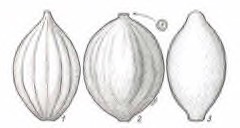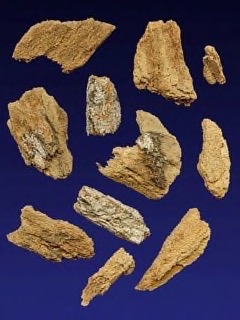 |
|
http://www.edibleplants.org |
 |
| H. Zell wikimedia.org |
Translate this page:
Summary
Okoubaka aubrevillei is a deciduous tree growing about 30 m in height and native to tropical Africa. It has a straight and cylindrical bole that can be up to 80cm in diameter. The crown is comprised of branches that hang low down. The bark is used medicinally for skin disorders and poisoning. It is found to have antimicrobial and immuno-stimulating properties. The wood of this species is sometimes used for constructions or as firewood.
Physical Characteristics

 Okoubaka aubrevillei is a deciduous Tree growing to 23 m (75ft) by 20 m (65ft) at a medium rate.
Okoubaka aubrevillei is a deciduous Tree growing to 23 m (75ft) by 20 m (65ft) at a medium rate.
See above for USDA hardiness. It is hardy to UK zone 10.
Suitable for: light (sandy), medium (loamy) and heavy (clay) soils, prefers well-drained soil and can grow in nutritionally poor soil. Suitable pH: mildly acid, neutral and basic (mildly alkaline) soils. It cannot grow in the shade. It prefers dry or moist soil and can tolerate drought.
UK Hardiness Map
US Hardiness Map
Synonyms
Octoknema okoubaka Aubr?v. & Pellegr.
Plant Habitats
Edible Uses
References More on Edible Uses
Medicinal Uses
Plants For A Future can not take any responsibility for any adverse effects from the use of plants. Always seek advice from a professional before using a plant medicinally.
Antibacterial Antidepressant Antidote Antifungal Leprosy Skin Tonic
The bark is widely used as a medicine in west Africa and is also exported to Europe and other countries. It is particularly employed in the treatment of skin disorders and poisoning. Six different catechins have been isolated from the bark, including (+)-catechin and (+)-gallocatechin, as well as_-sitosterol and stigmasterol[299 ]. The bark has antimicrobial and immunostimulating properties that are attributed to phenolic compounds[299 ]. A macerate of the bark is used in the treatment of tachycardia[299 ]. The bark is used in phytotherapeutic medicine in the Western world. Its main applications are for stomach upsets caused by poisoning and to boost the system in cases of tiredness, depression and allergies[299 ]. Skin problems, including those caused by syphilis and leprosy, are treated by washing with, or bathing in a macerate or infusion of the bark in water[299 ]. External application of bark preparations is also practised to counteract poisoning[299 ]. A bark macerate is taken as a vapour bath or as nose drops to cure oedema[299 ]. In a compress it is used to disperse haematomas[299 ]. A wooden tool is traditionally used for the removal of the bark, and under no circumstances is a metal implement used[299 ].
References More on Medicinal Uses
The Bookshop: Edible Plant Books
Our Latest books on Perennial Plants For Food Forests and Permaculture Gardens in paperback or digital formats.

Edible Tropical Plants
Food Forest Plants for Hotter Conditions: 250+ Plants For Tropical Food Forests & Permaculture Gardens.
More

Edible Temperate Plants
Plants for Your Food Forest: 500 Plants for Temperate Food Forests & Permaculture Gardens.
More

More Books
PFAF have eight books available in paperback and digital formats. Browse the shop for more information.
Shop Now
Other Uses
Fuel Wood
Other Uses The wood is sometimes used for construction or as firewood[299 ].
Special Uses
References More on Other Uses
Cultivation details
Natural regeneration is poor, because the fruits and seeds are eaten by porcupines[299 ]. In southern Nigeria, Okoubaka aubrevillei is an important tree in religious ceremonies[299 ]. It is considered to be a mystery plant in Cote D'Ivoire, and nobody would fell it. It belongs to a family of plants that includes many parasitic and hemiparasitic species and is said to kill trees around its growth place, though it has not been proven to be parasitic[328 ]. Okoubaka aubrevillei is a hemi-parasitic plant. Within 6 months after germination, when nutrient reserves in the seed become depleted, the roots attach themselves to those of nearby plants by means of haustoria. However, one year after germination no differences were found in growth and foliar nutrient concentrations between plants growing with and those without hosts. The hosts, however, showed increased mortality or reduced growth. Hence, the apparent benefit which this species gains from the parasitic association is killing potential competitors for water, light and nutrients. The only tree species surviving close to it are Myrianthus arboreus and Musanga cecropioides[299 ].
References Carbon Farming Information and Carbon Sequestration Information
Temperature Converter
Type a value in the Celsius field to convert the value to Fahrenheit:
Fahrenheit:
The PFAF Bookshop
Plants For A Future have a number of books available in paperback and digital form. Book titles include Edible Plants, Edible Perennials, Edible Trees,Edible Shrubs, Woodland Gardening, and Temperate Food Forest Plants. Our new book is Food Forest Plants For Hotter Conditions (Tropical and Sub-Tropical).
Shop Now
Plant Propagation
Seed - germination rates of 60 - 100% have been recorded[299 ]. Attempts have been made to cultivate this species. After germination, the seedlings were transplanted in rows 4 metres apart, at a distance of 2 metres within the rows. Between the rows, Millettia laurentii was planted to act as a host. After about 10 years, 54% of the plants had survived and had reached an average height of 4.2 metres, with a maximum height of 8.6 metres. The host plant, Millettia laurentii, grew well for the first 6 years, but then started dying[299 ].
Other Names
If available other names are mentioned here
Okoubaka tree, okoubaka aubrevillei
Native Range
Coming Soon
Weed Potential
Right plant wrong place. We are currently updating this section.
Please note that a plant may be invasive in one area but may not in your area so it's worth checking.
Conservation Status
IUCN Red List of Threatened Plants Status : Status: Endangered C2a(i)

Growth: S = slow M = medium F = fast. Soil: L = light (sandy) M = medium H = heavy (clay). pH: A = acid N = neutral B = basic (alkaline). Shade: F = full shade S = semi-shade N = no shade. Moisture: D = dry M = Moist We = wet Wa = water.
Now available:
Food Forest Plants for Mediterranean Conditions
350+ Perennial Plants For Mediterranean and Drier Food Forests and Permaculture Gardens.
[Paperback and eBook]
This is the third in Plants For A Future's series of plant guides for food forests tailored to
specific climate zones. Following volumes on temperate and tropical ecosystems, this book focuses
on species suited to Mediterranean conditions—regions with hot, dry summers and cool, wet winters,
often facing the added challenge of climate change.
Read More
Expert comment
Author
Pellegr. & Normand
Botanical References
Links / References
For a list of references used on this page please go here
A special thanks to Ken Fern for some of the information used on this page.
Readers comment
| Add a comment |
|
If you have important information about this plant that may help other users please add a comment or link below. Only comments or links that are felt to be directly relevant to a plant will be included. If you think a comment/link or information contained on this page is inaccurate or misleading we would welcome your feedback at [email protected]. If you have questions about a plant please use the Forum on this website as we do not have the resources to answer questions ourselves.
* Please note: the comments by website users are not necessarily those held by PFAF and may give misleading or inaccurate information.
To leave a comment please Register or login here All comments need to be approved so will not appear immediately.
|
Subject : Okoubaka aubrevillei
|
|
|
|